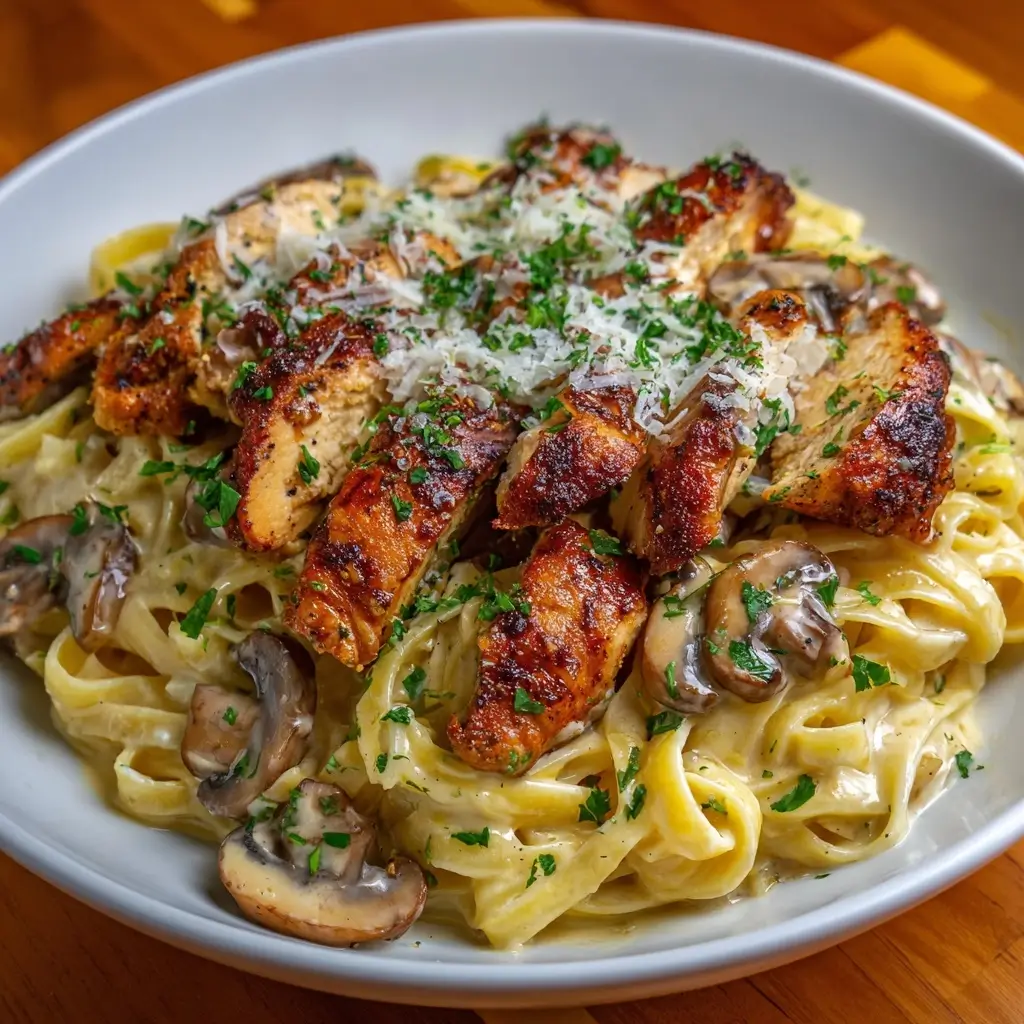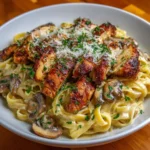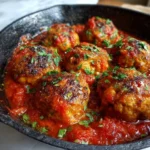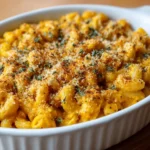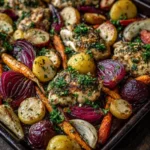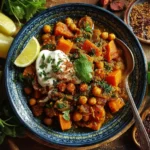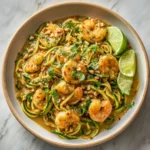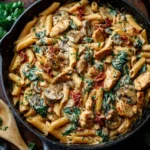Introduction
Cajun Spiced Chicken Alfredo Pasta is a bold and creamy fusion dish that brings together the rich, velvety textures of classic Italian Alfredo sauce with the fiery kick of traditional Cajun seasoning. This recipe offers a delightful marriage of flavors—creamy, cheesy indulgence meets smoky, spicy depth—making it perfect for food lovers who crave comfort with a punch. Whether you’re cooking for a family dinner, date night, or simply treating yourself to something extraordinary, this dish delivers both elegance and excitement on a single plate.
The History
The origins of this modern culinary hybrid trace back to two distinct traditions: Italian pasta dishes and Southern American Creole-Cajun cuisine. Alfredo pasta, named after Roman restaurateur Alfredo di Lelio, became famous in the early 20th century for its luxurious simplicity—butter, Parmesan cheese, and fresh fettuccine. Meanwhile, Cajun seasoning hails from Louisiana’s Acadiana region, where French-speaking settlers (Acadians) developed a robust spice blend influenced by Spanish, African, and Native American culinary practices. Over time, as American home cooks began experimenting with global flavors, the idea of spicing up traditionally mild dishes like Alfredo emerged. The result? A sensational twist that elevates the familiar with heat, depth, and complexity. Today, Cajun Spiced Chicken Alfredo Pasta stands as a testament to the creativity and cultural blending that defines contemporary American cuisine.
Ingredients Breakdown
To achieve the perfect balance of creaminess and spice in your Cajun Spiced Chicken Alfredo Pasta, every ingredient plays a crucial role. Let’s explore each one:
- Fettuccine Pasta: A flat, thick noodle ideal for holding onto rich sauces. Its starchy surface helps emulsify the Alfredo, ensuring every strand is coated.
- Chicken Breast: Boneless, skinless chicken breasts are lean and absorbent, making them perfect for marinating in Cajun spices and grilling or pan-searing to juicy perfection.
- Cajun Seasoning: A proprietary blend typically containing paprika, garlic powder, onion powder, black pepper, cayenne pepper, oregano, and thyme. This mix adds heat and earthy warmth.
- Heavy Cream: The base of the Alfredo sauce, providing richness and smooth texture. It carries the cheese and spices evenly throughout the dish.
- Butter: Adds silkiness and enhances mouthfeel. Unsalted butter allows better control over the overall salt content.
- Garlic: Fresh minced garlic contributes aromatic pungency that complements both the cream and the Cajun spice.
- Grated Parmesan Cheese: Aged Parmigiano-Reggiano melts beautifully into the sauce, adding nuttiness and umami depth.
- Oil (Olive or Vegetable): Used for searing the chicken without burning the spices, especially when using high heat.
- Salt and Black Pepper: Essential seasonings to enhance all other flavors.
- Optional Add-ins: Sun-dried tomatoes, spinach, mushrooms, or roasted red peppers can add color, texture, and nutritional value.
Step-by-Step Recipe
- Prepare the Chicken: Slice 2 boneless, skinless chicken breasts into thin strips or bite-sized pieces. In a bowl, toss them with 1–2 tablespoons of Cajun seasoning and a drizzle of olive oil. Allow to marinate for at least 15 minutes (or up to 2 hours in the fridge for deeper flavor).
- Cook the Pasta: Bring a large pot of salted water to a rolling boil. Add 12 ounces (about 340g) of fettuccine and cook according to package instructions until al dente. Reserve ½ cup of pasta water before draining. Set aside.
- Sear the Chicken: Heat 1 tablespoon of oil in a large skillet over medium-high heat. Add the seasoned chicken in a single layer and cook for 5–7 minutes, turning occasionally, until golden brown and cooked through (internal temperature should reach 165°F / 74°C). Remove chicken and set aside.
- Make the Alfredo Base: In the same skillet, reduce heat to medium and melt 4 tablespoons of unsalted butter. Add 4 cloves of minced garlic and sauté for about 1 minute until fragrant but not browned.
- Add Cream: Pour in 1 ½ cups of heavy cream, stirring gently. Bring to a simmer and let it reduce slightly for 3–4 minutes, allowing the flavors to meld and the sauce to thicken.
- Incorporate Cheese: Gradually whisk in 1 ½ cups of freshly grated Parmesan cheese, a handful at a time, stirring constantly until fully melted and smooth. Avoid pre-grated cheese, which often contains anti-caking agents that hinder melting.
- Adjust Seasoning: Taste the sauce and adjust with additional salt, black pepper, or more Cajun seasoning if desired. If the sauce is too thick, thin it with reserved pasta water, one tablespoon at a time.
- Combine Everything: Add the cooked fettuccine and seared chicken to the skillet. Toss everything together until well-coated and heated through. Let it simmer gently for 2–3 minutes so the pasta absorbs some of the sauce.
- Serve Immediately: Plate the pasta while hot, garnished with extra Parmesan, chopped parsley, and a sprinkle of red pepper flakes for added heat.
Tips
- Use Freshly Grated Cheese: Pre-shredded cheeses contain cellulose, which can make the sauce grainy or prevent proper emulsification.
- Don’t Overcook the Garlic: Burnt garlic turns bitter. Sauté just until fragrant—about 30–60 seconds.
- Reserve Pasta Water: The starchy liquid helps bind the sauce to the noodles and improves texture.
- Control the Heat: Cajun seasoning varies in spiciness. Start with less and add more after tasting the finished dish.
- Cook Chicken Evenly: Cut chicken into uniform pieces to ensure even cooking and avoid dry spots.
- Rest the Chicken: After cooking, let the chicken rest for a few minutes before adding it to the sauce to retain juiciness.
- Simmer Gently: Never boil the cream sauce vigorously after adding cheese; low and slow prevents separation.
- Double the Batch: This dish reheats well and makes excellent leftovers—just add a splash of milk or cream when warming.
Variations and Customizations
This versatile recipe lends itself to countless adaptations based on dietary preferences, seasonal ingredients, or pantry availability:
- Protein Swaps: Replace chicken with grilled shrimp, smoked sausage, or pulled pork for different regional twists. For a vegetarian version, use portobello mushrooms or crispy tofu.
- Pasta Alternatives: Try fettuccine substitutes like pappardelle, tagliatelle, or gluten-free pasta made from rice, chickpeas, or lentils.
- Dairy-Free Version: Use coconut cream instead of heavy cream, nutritional yeast or vegan Parmesan, and plant-based butter for a dairy-free Alfredo.
- Keto-Friendly: Swap regular pasta for zucchini noodles (zoodles), spaghetti squash, or shirataki noodles. Ensure your Cajun seasoning has no sugar.
- Add Vegetables: Stir in baby spinach, kale, roasted bell peppers, artichoke hearts, or asparagus during the final mixing stage for added nutrition and color.
- Spice Level Adjustments: Reduce cayenne in homemade Cajun seasoning for milder heat, or increase it—or add hot sauce—for extreme spice lovers.
- Herb Infusions: Add fresh basil, thyme, or rosemary to the sauce for an aromatic lift that balances the richness.
- Creaminess Boosters: Blend in mascarpone or cream cheese for an even silkier, more decadent sauce.
- Smoky Twist: Add a pinch of smoked paprika or chipotle powder to deepen the smokiness of the Cajun profile.
Health Considerations and Nutritional Value
While undeniably delicious, Cajun Spiced Chicken Alfredo Pasta is a rich, calorie-dense meal. Understanding its nutritional components can help you enjoy it mindfully:
- Calories: One serving (approximately 1.5 cups) ranges from 600–800 calories depending on portion size, cheese amount, and added oils.
- Fat Content: High in saturated fat due to heavy cream and butter. Opt for lower-fat alternatives cautiously, as they may compromise texture.
- Protein: Chicken provides lean protein (~30g per breast), supporting muscle repair and satiety.
- Carbohydrates: Fettuccine contributes complex carbs (~40g per serving), offering energy—but consider whole wheat pasta for added fiber.
- Sodium: Can be high due to cheese, seasoning blends, and added salt. Choose low-sodium Cajun blends and limit added salt when possible.
- Calcium & Vitamins: Parmesan offers calcium and vitamin B12, while garlic supports immune health and contains antioxidants.
- Moderation Tips: Serve with a side salad or steamed vegetables to balance the meal. Use half the cheese and cream, or substitute part with Greek yogurt (added off-heat).
- Allergens: Contains dairy, gluten, and eggs (in most pastas). Always check labels for allergen cross-contamination if serving sensitive individuals.
Ingredients
- 12 oz (340g) fettuccine pasta
- 2 boneless, skinless chicken breasts, sliced into strips
- 2 tbsp Cajun seasoning (store-bought or homemade)
- 2 tbsp olive oil (divided)
- 4 tbsp unsalted butter
- 4 cloves garlic, minced
- 1 ½ cups heavy cream
- 1 ½ cups freshly grated Parmesan cheese
- Salt and freshly ground black pepper, to taste
- Chopped fresh parsley, for garnish
- Optional: red pepper flakes, sun-dried tomatoes, spinach, mushrooms
Directions
- In a bowl, combine chicken strips with 1 tablespoon of Cajun seasoning and 1 tablespoon of olive oil. Marinate for 15–30 minutes.
- Bring a large pot of salted water to a boil. Cook fettuccine until al dente. Drain, reserving ½ cup of pasta water.
- Heat 1 tablespoon of oil in a large skillet over medium-high heat. Add chicken and cook 5–7 minutes until golden and cooked through. Remove and set aside.
- In the same skillet, melt butter over medium heat. Add garlic and sauté for 1 minute until fragrant.
- Pour in heavy cream, bring to a gentle simmer, and cook for 3–4 minutes to slightly reduce.
- Gradually stir in Parmesan cheese until smooth and creamy. Season with salt, pepper, and remaining Cajun seasoning to taste.
- If needed, thin the sauce with reserved pasta water, 1 tablespoon at a time.
- Add cooked pasta and chicken to the skillet. Toss well to coat and heat through for 2–3 minutes.
- Garnish with parsley and extra Parmesan. Serve immediately.
FAQ
Can I make this ahead of time?
Yes, but best results come from assembling just before serving. Store components separately: cooked chicken, sauce, and pasta. Reheat sauce with a splash of cream, then combine.
How do I store leftovers?
Keep in an airtight container in the refrigerator for up to 3 days. Reheat gently on the stove with added milk or broth to restore creaminess.
Can I freeze Cajun Chicken Alfredo?
Freezing is not recommended due to dairy separation. The sauce may become grainy or oily upon thawing.
What can I use instead of heavy cream?
Half-and-half or full-fat coconut milk work in a pinch, though the sauce will be thinner. Avoid non-dairy milks unless thickened with cornstarch.
Is Cajun seasoning very spicy?
It depends on the brand or recipe. Some blends are mild and herby; others are fiery. Always taste first and adjust accordingly.
Can I use pre-cooked chicken?
Absolutely! Rotisserie chicken or leftover grilled chicken works well. Add it at the end just to warm through.
Why did my sauce break?
Sauces break when overheated or when cheese is added too quickly. Always keep heat low and whisk constantly. If broken, try blending in a tablespoon of cold butter or a splash of cold cream.
Can I make it gluten-free?
Yes—use certified gluten-free pasta and verify that your Cajun seasoning is gluten-free (some contain fillers).
Summary
Cajun Spiced Chicken Alfredo Pasta combines creamy Italian indulgence with bold Louisiana heat for a restaurant-worthy dish you can make at home. Packed with tender chicken, al dente pasta, and a luxuriously spiced Alfredo sauce, it’s comfort food with a thrilling kick.
